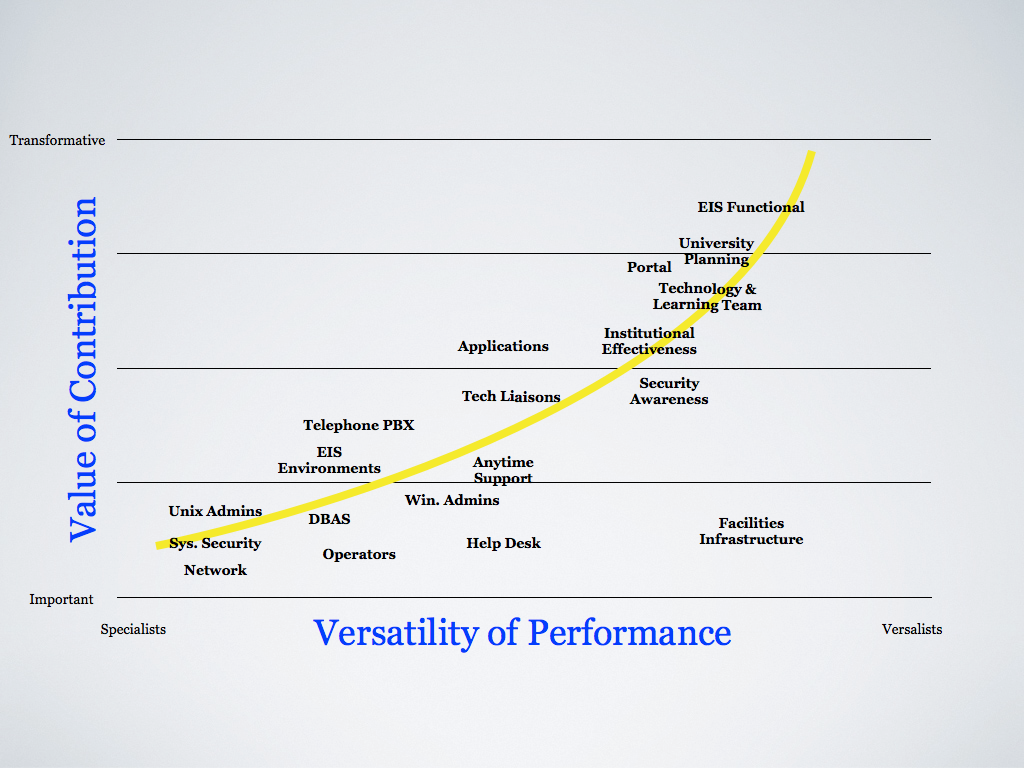Key Takeaways
- Conceptualizing your IT services along the IT value curve helps you think about which of your services are transactional and which are transformative.
- Transactional services make better candidates for outsourcing because they are important, but less strategic, and best measured by concepts easily quantified and benchmarked through a service level agreement.
- More strategic services that have transformative potential should be performed by IT's best and brightest because both the institution's and the IT organization's future depend on developing and leveraging this expertise in-house.
- By outsourcing its help desk, Pepperdine University now provides better service at reduced cost, with savings realized through improved economies of scale and resources freed up for investment in more transformative services.
For many organizations, the notion of outsourcing IT services is frowned upon, for reasons such as increased risk, lack of control, or the importance of local knowledge. However, in addition to potentially reducing costs, outsourcing has the benefit of freeing staff time in the IT organization so that it can devote more time and resources to strategic initiatives central to the institutional mission. In 2008, by outsourcing the IT help desk function at Pepperdine University, the institution was able to reduce its costs and reallocate the savings to a technology and learning center for faculty. This has had a significant, positive impact on our technology and learning practices across the university.
Outsourcing and the IT Value Curve
One challenge for IT leaders is to develop a clear set of criteria that offers guidance when considering the myriad of outsourcing opportunities; otherwise, outsourcing arrangements face greater risk of falling short of expectations. The concept of the IT value curve1 provides a framework for thinking about which IT services are better candidates for outsourcing and how performance expectations are best understood.
The IT value curve proposes that roles and expectations for IT organizations flow from the intersection of two different dynamics:
- Value of contribution: the difference between services that are important, but not strategic, and services that have transformative potential
- Versatility of performance: the difference between performance based on narrow, but deep, sets of technical skills versus performance based on mastery of a broad set of competencies above and beyond technical skills
Services that reside on the lower, left-hand part of the IT value curve are transactional services. While important, they have less transformative potential and, from an end user point of view, expectations tend to revolve around consistency, reliability, efficiency, responsiveness, and standardization. Services that reside in the upper, right-hand part of the IT value curve are strategic services and tend to be provided by versalists, who have mastered competencies such as business enterprise knowledge, change advocacy, capacity to develop and empower others, and strategic planning. The IT Leadership Council at Pepperdine developed the alignment of IT services captured in Figure 1.

Figure 1. IT Value Curve for Pepperdine IT Services
From the perspective of the IT value curve, transactional services are better candidates for outsourcing because they are important, but not strategic, and best measured by concepts easily quantified and benchmarked through a service level agreement (SLA). More strategic services are less than ideal candidates, and IT organizations should shy from outsourcing work that has transformative potential. This work should be performed by IT's best and brightest because the future of the IT organization and the institution depends on developing and leveraging this expertise in-house.
Does this mean that all transactional services should be outsourced? No, outsourcing is not that simple. There is another important criterion: economies of scale. Will the outsourced service take advantage of economies of scale in a way that cannot be duplicated in-house? When it comes to services like the call center or e-mail, a vendor can easily scale up to support additional customers in a way that results in lower per-unit costs for everyone. This typically presents an opportunity to reduce costs. When IT organizations find an opportunity to leverage better economies of scale for transactional services, these opportunities should be strongly considered. Such was the case with the IT help desk at Pepperdine University in the summer of 2007.
The Need for Anytime Support
In 2007, Pepperdine's IT help desk supported a community of approximately 7,800 students, 500 faculty, and 750 employees. Over the course of any given year, approximately 28,000 calls were logged at the help desk. Pepperdine uses annual Higher Education TechQual+ surveys to assess IT service outcomes and to support IT strategic planning.2 The results of the 2007 TechQual+ survey suggested the existence of significant problems with the IT help desk.
Students expressed concerns mainly in the areas of responsiveness, reliability, and consistent service quality. For some students, availability was also an issue. The IT help desk was only available from 7 a.m. until 9 p.m. Monday–Friday, with limited availability on the weekend. A significant number of undergraduate students, approximately 500, were studying overseas, and a larger number of fully employed professional students, about 1,800, were taking evening courses, which suggested the need to provide IT help desk service on a 24 × 7 basis. In an effort to extend services, in late 2007 IT managers expanded availability to midnight during the work week, but this had the unintended impact of reducing performance, as staff resources were thinned during peak hours.
While exploring ways to improve the IT help desk, IT leaders conducted an exercise to benchmark the services provided against services provided by a commercial alternative. Table 1 shows this comparison.
Table 1. Comparison of Help Desk Service Provision
| Factor | In-house | Outsourced |
| 8 to 5 business hours availability | Yes | Yes |
| 24 by 7 availability | No | Yes |
| Local (506) telephone access (4 digit dialing) | Yes | Yes |
| Toll free (1-800) telephone access | No | Yes |
| Easy access from outside Southern California | No | Yes |
| Remote PC control available for troubleshooting | No | Yes |
| Expertise regarding basic, Tier 1 support | Strong | Strong |
| Expertise regarding advanced, Tier 1 support | Weak | Strong |
| Capabilities regarding Windows/OS X/MS Office support | Average | Strong |
| Capabilities regarding PeopleSoft support | Weak | Average |
| Capabilities regarding Blackboard support | Weak | Strong |
| Contextualized services specific to Pepperdine | Strong | Requires time |
| End-user satisfaction survey scores | 4.39 (5.00 scale) | 4.44 (5.00 scale)* |
| Average wait time to answer | 89 seconds | 60 seconds* |
| Call abandonment rate | 15.30% | 10%* |
| First call resolution rate | 52.70% | 60%* |
Based on this comparison, we made the decision to investigate the outsourced option in further detail. During this detailed review, IT leaders visited the vendor's call center and reviewed their infrastructure, facilities, and service. This included listening to several support telephone calls in real time. Additionally, IT leaders conducted reference calls with several of the vendor's customers. Reference calls with several users of the in-house IT help desk were also conducted to ensure an equal review of both services. Based on this review, including a detailed analysis of costs and services, as CIO I recommended to the University Management Committee that Pepperdine proceed with outsourcing the IT help desk, with any savings to be reallocated to support technology and learning resources for faculty. This recommendation was accepted.
Proceeding with the Implementation
In August 2008, the IT leadership team began contract negotiations with the vendor, successfully completing the process within a month. A mutually agreeable contract was then executed. Key elements of the contract included the following:
- An SLA focusing on key, quantifiable benchmarks that indicate responsiveness, reliability, consistency, and effectiveness from an end-user's point of view. Four criteria were selected:
- Average wait time: the number of seconds the caller waits until the help desk answers the call
- Call abandonment rate: the percentage of callers who hang up while waiting for the help desk to answer the call
- First call resolution rate: the percentage of issues resolved on the first call by the help desk staff
- End-user satisfaction scores: the average score on a satisfaction survey randomly distributed to individuals who request support from the help desk
- A well-defined management plan that noted in precise detail the frequency, duration, and desired outcomes of regular meetings between the outsourced help desk management and the Pepperdine staff responsible for the help desk service. At first, these meetings were daily; they now occur less frequently. This helps ensure that Pepperdine staff is managing the service just as if it were provided on-site.
- A technical plan that ensured seamless delivery of the service, as provided by in-house staff in the past. Calls to the previous IT help desk telephone number were transferred seamlessly and transparently to the new service, and staff at the outsourced help desk have secure access to Pepperdine systems as necessary to support faculty, students, and staff with Pepperdine technology services.
The internal team also began the planning and coordination with Human Resources and the Office of the General Counsel to manage the resulting reduction in workforce, which affected a few employees who could not be placed in other IT positions.
On October 1, 2008, the change in IT help desk service was announced to the university. This announcement included interviews with the student newspaper, wide distribution of a FAQ sheet, and a town hall meeting with all IT employees. Implementation started immediately, as both the in-house and external teams began working to transfer knowledge in preparation for a cutover on November 1, 2008. This was a silent, transparent switch, as calls to the existing help desk number were routed to the new off-site call center. The new service, branded the Anytime Support Desk, was formally announced on January 1, 2009.
During due diligence, the IT leadership team became increasingly aware that many outsourcing projects fail to meet expectations if managed in a hands-off fashion. Thus, it was very important that the new IT help desk service be managed, marketed, and supported just as if it were still maintained in-house. Yet, because managing a vendor relationship and vendor-provided services requires different skills, the selection of a new IT help desk manager was a key requirement. Ultimately, the leadership team promoted an existing employee with the right competencies. In many ways, the project's success came about because the new director manages the outsourced staff as if they are his own employees, located adjacent to his office. More than anything else, this approach has helped ensure the success of this outsourced service.
Director Jerry Hoover talks about Anytime Support:
Jerry Hoover
Pepperdine student Betty Rengifo Uribe talks about the new help desk:
Pepperdine Professor John Rehfeld talks about the help desk:
John Rehfeld
Enabling Transformation
This change has had some significant positive outcomes for the broader Pepperdine community of faculty, students, and staff and for the IT organization. The agreed upon SLA benchmarks show that the outsourced service is superior in terms of responsiveness, reliability, and consistency.
Table 2. In-House Versus Outsourced Benchmarks
| Factor | In-house (2007–2009) | Outsourced (2010–2011) |
| End-user satisfaction survey scores | 4.39 (5.00 scale) | 4.60 (5.00 scale) |
| Average wait time to answer | 89 seconds | 47 seconds |
| Call abandonment rate | 15.30% | 5% |
| First-call resolution rate | 52.70% | 84.2% |
All indications are that by switching to the outsourced provider, we have provided a service that significantly improves over the previous in-house service.
Moreover, in leveraging these services, Pepperdine has tapped in to economies of scale previously not available. Per-call costs have dropped from $24.25 to $16.88, resulting in a hard dollar savings of approximately $250,000. These funds have been reallocated to support the establishment of a technology and learning center whose mission is to engage faculty proactively regarding the transformative potential of learning technologies. Using the reallocated funds, three new positions were created, including a director of the center. These three staff support or lead projects such as Pepperdine's iPad classroom initiative, transition from Blackboard to Sakai (another project that is reaping significant cost savings for the institution), and development of new hybrid programs in the Graduate School of Education and Psychology.
These results have been evident in our recent 2011 TechQual+ survey of IT service outcomes. Compared to previous TechQual+ surveys of faculty since 2008, the most recent data show that faculty perceptions regarding university technology services have dramatically improved.
| Year | No. of TechQual+ Service Outcomes Below Minimum Expectations | No. of TechQual+ Service Outcomes Above Minimum Expectations |
| 2008 | 9 | 9 |
| 2009 | 11 | 7 |
| 2010 | 1 | 17 |
| 2011 | 1 | 17 |
By leveraging better economies of scale for transactional services and reinvesting the savings in strategic services, IT staff have taken a poorly performing function and turned it into a positive force for influencing Pepperdine faculty and changing our learning practices. Remember, when thinking about outsourcing, to always consider alternatives for transactional services and focus more of your energies on the strategic. Otherwise, your efforts at enhancing the effective delivery and use of technology will most likely fall short of expectations.
Key Criteria for Successful Outsourcing
- Is this a transactional, commodity service that, while important, is not necessarily a strategic service with transformative potential?
- Are there easily identifiable, quantifiable benchmarks indicating responsiveness, reliability, consistency, effectiveness, and cost that can be fashioned into a service level agreement?
- Can the vendor create economies of scale across its entire customer base that result in lower per-unit costs for everyone? Will this service reduce costs in a way that allows for reinvestment by the IT organization in more important, strategic services?
- Timothy M. Chester, "Technical Skills No Longer Matter," EDUCAUSE Review (January/February 2011).
- For more information on the Higher Education TechQual+ Project, please visit http://www.techqual.org.
© Timothy M. Chester. The text of this EQ article is licensed under the Creative Commons Attribution-Noncommercial 3.0 license.



